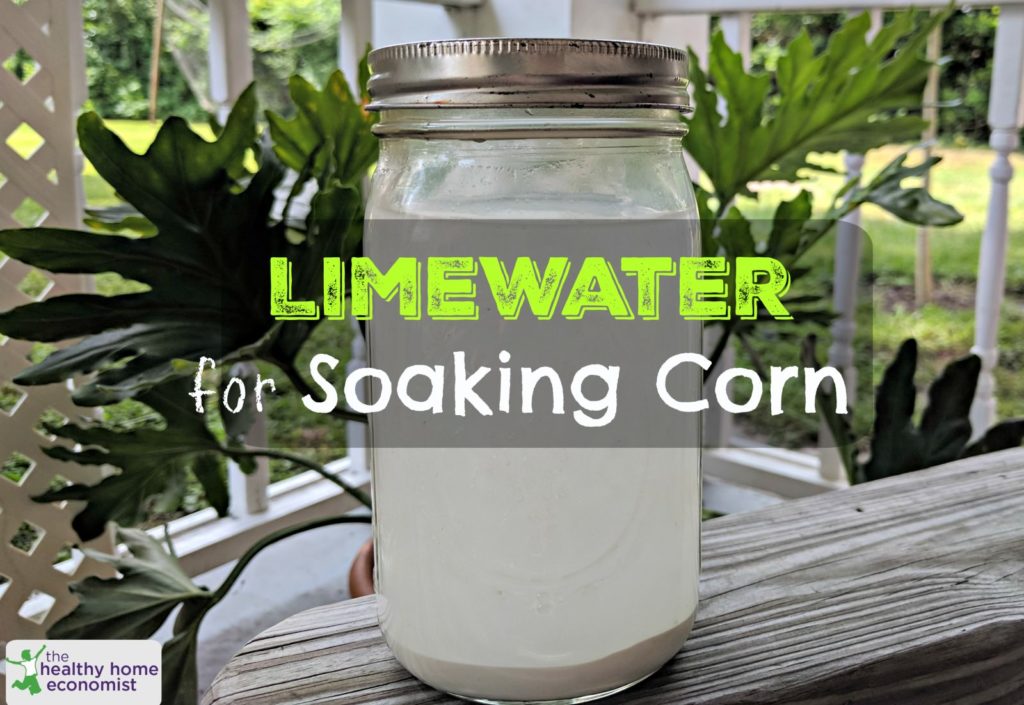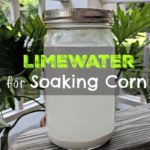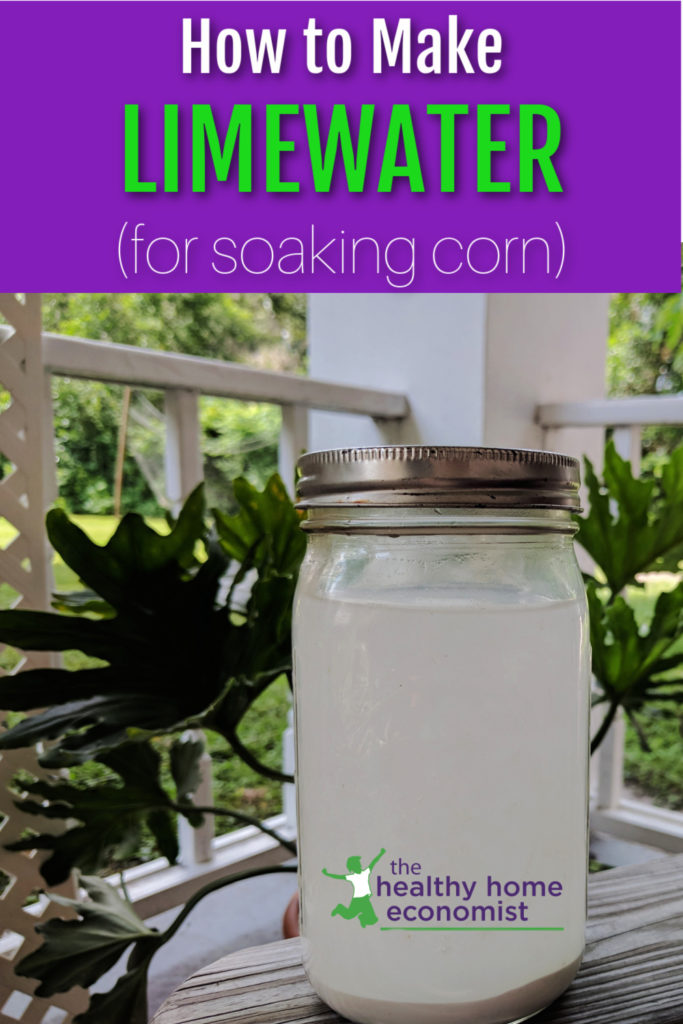Table of Contents[Hide][Show]
How to make limewater for soaking corn in accordance with traditional Native American cultures for improved digestibility and bioavailability of nutrients.

Corn has a bad rap these days primarily due to the pervasive presence of high fructose corn syrup (HFCS) in the food supply. This frankenfood is generally made with GMO corn and laced with mercury residue from processing. (1)
It is in the majority of processed foods and drinks and is being blamed for all sorts of health woes including a role in the obesity epidemic.
The truth is, however, that corn is a traditional food! When high quality, nonGMO corn is sourced and prepared properly using limewater, it can be both delicious and healthy!
And, if you are a Southern gal like me, you like your corn – am I right?
Grits and homemade cornbread anyone?
Why Soak Corn?
Soaking corn or cornmeal overnight in limewater releases Vitamin B3. It also improves the amino acid profile of the corn making for easier digestion.
Note, you do not have to soak cornstarch. The reason is that the nutritional value of cornstarch is very low as it is basically just pure carbohydrate.
If whole food forms of corn are a staple in your diet, then soaking in limewater is a must. The disease pellagra is caused by Vitamin B3 deficiency. Symptoms of pellagra include sore skin, mental problems, and fatigue. Most doctors fail to ever diagnose it!
Even if you don’t eat corn that frequently, limewater is easy to make and lasts for a long time in the refrigerator or cool pantry. Why not soak your corn to create homemade corn dishes? It is an easy to do step that improves the nutrition and digestibility of the meal.
In the video included with the recipe below, I show you how to make limewater using the Nourishing Traditions method. It is the proper soaking medium for corn in North and South American traditional societies. The healthy, strong, and fierce Seminole Tribe of Florida, for example, sustained themselves primarily on soaked corn gruel.
Masa Harina?
Note that preparing masa harina is slightly different. This type of corn flour has already been treated with lime. Thus, limewater is not needed, however, it will still require soaking in a slightly acidic medium like buttermilk or water with a squeeze of lemon juice. This serves to deactivate anti-nutrients like phytic acid.

Homemade Limewater Recipe
How to make limewater using the traditional method that will create more nutritious and digestible corn based dishes for your family. Can also be sipped as a beverage for extra calcium!
Ingredients
- 4 Tbl dolomite powder
- filtered water
- 1 quart mason jar
Instructions
-
Spoon dolomite powder into a 1 quart mason jar. It should be spread evenly about 1/2 inch deep at the bottom of the jar.
-
Fill the mason jar with filtered water. Leave about 1 inch at the top.
-
Screw on the lid tightly and turn a few times to mix the dolomite powder in the water.
-
Leave the jar on the counter until the dolomite fully settles out at the bottom of the jar. This will take a few hours, and then the water will be clear.
-
Place the jar in the refrigerator or cool pantry. Use this water for soaking corn and corn flour for any corn based dishes.
Recipe Video
Recipe Notes
Use 1 cup of limewater for every 2 cups of corn or cornmeal for making cornbread, corn casserole and other corn based dishes.
Pour the limewater out of the mason jar carefully - you don't want to use the lime that has settled at the bottom, only the limewater. Soaking for 12-24 hours is sufficient to release the nutrients but cornbread in particular will rise better if soaked for 24 hours.

Recipes using Soaked Corn
With your limewater ready to go, here are a few recipes to try that require the soaking of corn flour and meal.








This throws a bit of a problem into the discussion but here is my observation over the last 36 hours or so! I conducted an experiment with trusty baking soda, alkali. Put 1 cup of yellow cornmeal into a container, added 1 cup of water, and a generous teaspoon of baking soda. I wanted to see whether the mixture would turn orange, as I’d read that nixtamalization does this to corn kernels treated with lime water or at least deepens the color. I had a control, without the baking soda. The baking soda solution turned the color of turmeric – at least the soak water did; it’s kind of hard to distinguish the grains from the soak water and soaking continues. I added the control to the darker colored solution, and some more baking soda. Plan to use this Sunday for a main meal.
Corn is a bit stimulating as a grain, I read. No wonder I couldn’t sleep that well after eating it, and it also is a diuretic. But, the color is wonderful and maybe with the new routine, it will evoke a more mellow response with me. It is good for the physical and the spiritual heart, I read.
Blue corn is entirely different; different nutritional profile entirely, just about. Different type of selenium, and different amino acid profile, protein profile. It seems more calming to me. I use grains because I like the taste and the calming effects very much, as do others I am sure.
The Indians of the America’s used wood ash lime which is caustic to process corn to release the much needed B vitamin niacin…Such lime is pure since the fire burning the wood can be 500 degrees and destroys any germs. Ground up dolomite limestone is not caustic and gives you calcium and may be pure but it doesn’t do a thing for helping the niacin bound up in the corn be digestable. Corn soaked in it is not true masa corn. For those interested google nixtamalization– it even includes the word tamali in it, how neat is that!
Can you buy cornmeal or you need to grind up soaked corn? To make cornbread from cornmeal can you soak the cornmeal overnight?
Cornmeal goes rancid very quickly, so it is best to grind your own.
Is this something I can do to prepare popcorn kernels?
Hi, I’m making a cornbread mix and I want to soak it in lime water first. Does the lime water -replace- the amount of milk called for in the recipe?
If the lime water does not replace the milk, then won’t there end up being too much liquid in the mix? My mix calls for 1 cup of milk. So I would have 1 cup of lime water as well as 1 cup of milk, which would make twice the liquid. Sorry, just trying to understand. Also, nourishing traditions says to soak in lime water and then soak it in kefir after that. So, would I soak it in 1 cup of lime water and then add a cup of kefir to soak longer?
Thanks so much!
Sarah, great video! Question: For the soaking process, I use 1 cup of lime water for every 2 cups of cornmeal. Do I add more water for the soak? And then rinse it before using? Or just soak the 2 cups of cornmeal in 1 cup of limewater and use as is?
Don’t use more water. Use the soaked flour as is once the soaking is complete.
Can I reuse the lime multiple times?
The dolomite gets really hard when it settles on the bottom of the mason jar, so I would use a fresh batch.
I am using pickling lime (calcium hydroxide) and when I shook the jar, it was nearly as powdery as the first time, so would this indicate that it is ok to use again? Also, should I then soak the corn in whey along with ground rye to break down the phytic acid? Thank you.
I was wondering if I took the KAL Dolomite Tablets, 250.4 mg, 500 Count
from Kal before eating corn meal/bread/tortilla’s etc… would that be as good? Since I don’t eat that much of the corn products…
Great site, just wondering….
Ja
Wondering if anyone notices a difference between using calcium carbonate (dolomite powder) vs calcuim hydroxide (pickling lime)? I soaked my dent corn in both and the calcium carbonate did nothing while the calcium hydroxide disolved the outer skins of the corn and turned the water yellow. Guess I should stick to the calcium hydroxide.